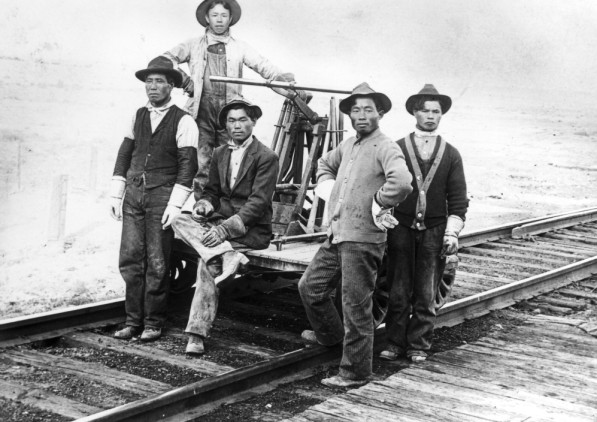For over a century and a half: Chinese workers abused and superexploited in U.S.
The six Asian spa workers murdered in Atlanta March 16 were low-wage workers. They were not respected by capitalism. Their deaths came on a surge of anti-Asian violence.
Anybody with an honest view of the U.S. wars against Korea and Vietnam is familiar with anti-Asian racism. The U.S. stands guilty before the world in the deaths of four million people, caused by these two imperialist wars against Korea and Vietnam.

Chinese railroad workers in 1869.
U.S. imperialism has a history of domestic terrorism stemming from the exploitation and forced migration of Asian labor starting in the 1840s. Anti-Asian violence “is rooted in a long history of anti-Asian sentiment that recruited Asian labor, but denied them the rights of citizenship through exclusive laws and policies,” wrote Linh Thy Nguyen, an assistant professor in the Department of Asian Studies at the University of Washington.
The first big wave of Chinese immigration to the U.S. took place during the California Gold Rush of the late 1840s. After the violent annexation of Mexico, the bosses often used mob rule in California and throughout the West; they pitted white workers against Asian workers, making them the scapegoats for the grievances of labor. In Los Angeles in 1871, the small Chinese community was attacked after an internal dispute spilled over. Nineteen Chinese people were lynched — and no one was held accountable.
Leland Stanford, a major investor in the Central Pacific Railroad, despised Chinese labor, but he hired thousands of Chinese workers when construction of the Central Pacific line began in 1863. The building of this rail line was a huge project to connect a transcontinental railroad. The Central Pacific started at Sacramento, Calif., and headed east. The Union Pacific started in Omaha and headed west.
Chinese workers made up about 13,000 of the 15,000 workers on the Central Pacific. They did backbreaking labor year-round, under the hot sun and in the bitter winter. Without any power equipment, they excavated and tunneled through mountains, hauled rock by hand, graded the roadbed and laid track — all with high-speed, coordinated efforts. They dug 11 tunnels through the mountains and worked in fierce winter storms that left 18 feet of snow on the summits.
The Chinese workers were paid less than the others. They had to sleep outside in tents, while other workers usually slept in rail cars. In a competition with workers building the eastern line, the Chinese outpaced them, laying ten miles of track in one day.
The two rail lines were joined in the “golden spike” ceremony at Promontory Summit, Utah, on May 10, 1869. But little recognition was paid to the Asian workers, who had toiled for six years at the cost of hundreds of their lives. No Asians can be seen in the photographs showing the hundreds of people at the ending ceremony.
Dr. Gordon Chang of Stanford University says, “Leland Stanford became one of the world’s richest men by using Chinese labor.” And Chinese workers went on to build other railroads throughout the West.
Chinese built the railroads
About two-thirds of the workers who built the Western Division of the Northern Pacific railroad, running from Lake Superior to Tacoma, Wash., were Chinese. And there were Chinese people working as miners and in other difficult occupations.
In 1882, after all these feats of labor, the Chinese Exclusion Act was passed. It suspended all Chinese immigration to the U.S. for ten years. In addition, Chinese immigrants and their U.S.-born family members remained ineligible for citizenship — until 1942!
By the mid-1880s there was widespread anti-Chinese sentiment. In 1885 in Rock Springs, Wyo., a gang of white miners rampaged through town and murdered 28 Chinese miners. The Chinese were blamed for being strikebreakers, but that had happened many years earlier.
In the winter of 1885-86, 350 Chinese were expelled from Seattle and about the same number from Tacoma, Wash. were known as the anti-Chinese riots. The Knights of Labor were caught up in the racist crusade — against the interests of labor. Chinese communities were harassed, attacked or expelled in 34 towns in California.
The worst anti-Chinese pogrom of all was almost completely covered up. In May 1887, 34 Chinese miners were massacred in Hells Canyon, along the Snake River running between Oregon and Idaho. These gold miners were shot by a gang of racist thieves, who then mutilated their bodies and threw them in the Snake River. The gang stole all the miners’ gold. While a few of the racist gang were captured, their prosecution wasn’t pursued. Most of them escaped to Canada.
It wasn’t until 2005 that this event was given recognition, and a memorial was placed on a five-acre site, renamed the Chinese Massacre Cove. The victims were honored on a plaque in three languages: Chinese, English and Nez Perce.
In 1969, on the centennial of completion of the first U.S. transcontinental railroad in Utah, the Chinese delegation was snubbed, ignored and upstaged by John Wayne.
But in 2019, on the 150th anniversary of the event at Promontory Summit, thousands of descendants of the Chinese workers came; they had been organizing for years to set the record straight. The Chinese workers were finally incorporated into the honor of the “golden spike” ceremony.
The event marked the culmination of a lifelong effort to recover the history of their families and communities. Uniting the country, the building of the transcontinental railway had been one of the greatest feats of human labor in the modern capitalist era.

